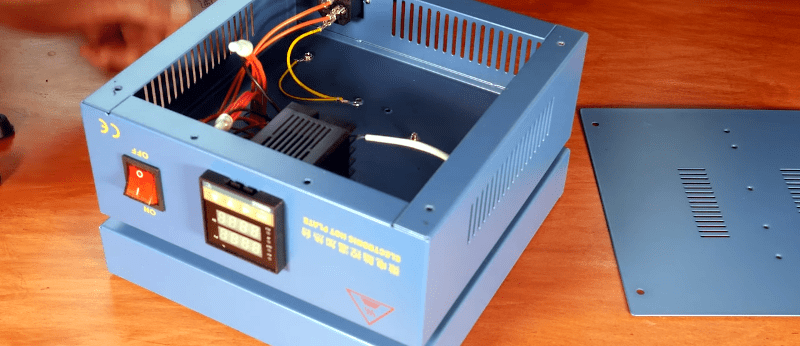[EEforEveryone] is trying to find a good hot plate for reflow soldering. After trying one cheap unit, he got another one. He was a bit underwhelmed. The grounding was suspect and the bed wasn’t totally flat. He tore it apart and was surprised that there was very little inside. While the construction wasn’t perfect, it was better than the previous unit. You can see a video of the teardown and review below.
Before powering it up, the first order of business was to rewire the ground system. After that, it was time to try it. However, by confusing Fahrenheit and Centigrade, he set the temperature much higher than necessary which creating a little smoke. Fixing the temperature helped, but there was still a bit of a smoky smell that eventually subsided.
The verdict? The hot plate worked well enough, but you probably do want to check the ground wiring before using it. That’s often a good idea where cheap equipment is concerned, anyway. But the real takeaway is that it looks like you could homebrew something equivalent without much trouble. The controller is an off-the-shelf module. A switch and a plug aren’t hard to figure out. The heating element could be a silicone heater or PCB heater meant for a 3D printer.
Of course, there are other options. You could use a wok. Or why not a waffle iron? You can also make a custom PCB.















It’s a hotplate. How complicated do you expect it to be?
There are a huge number of homebrew hotplates around, from repurposed irons through to profile-managed heated/cooled enclosures.
I use a $20 electric skillet I got at [Wal-Mart], although my needs in this area are modest.
Why are you surprised there was no “Bells” and “Whistle” parts inside. At work we made a “Warmer plate”, no get hot “raw” pcbs. Soldering becomes a breeze, if the pads and eyelets are not cold. It was just a 120vac hot pad, 1/4″ thick aluminum plate, PID controller with thermal probe and SSR. The bare min.
Why are people surprised that when they but a cheap device it’s not full of expensive components?
Good point!
But of course, things made in China use Keebler elves, so I guess they still expect a lot for some reason.
I have one of these and can 100% recommend it. Worth every penny. Using it to solder surface mount parts with help of a solder stencil and the difference between this and just hot air is night and day.
Only downsides compared to a reflow oven is that you can only have parts on one side of the board but that’s fine because that’s how I design my boards anyway and if you have parts that sit in board cutouts (right angle board edge buttons and a usb c connector in my case) that can therefore extend below the PCB you’ll have to prop the board up. But that’s easily done by just using another identical board and screwing them together using their mounting holes.
I was worried that would cause the top layer to be too insulated from the hot plate, but strangely that actually works _better_ than just one PCB probably because it is harder for the screwed together double board stack to warp.
I’m clearly doing something wrong as I use my one for keeping a mash warm when brewing beer. Quite a sturdy little hot plate.
I’ve also been using this method for reflowing, though with just aluminum plate on electric stove. Much easier and more repeatable than any other methods (including DIY reflow oven) have been for me.
The information about “propping up” is interesting.
For double-sided assembly, one can always do the second side with hot air blower.
The smoke is probably the oxidation on that cheap stainless plate burning off.
Dunno why people seem to think there is more to a heat plate. Could be worse and uses Mains with a huge resistor to drop the current and voltage like I’ve seen in those Glade Plugins.
I have one at my lab and the problem was that a heating elements under aluminum plate was hold in place by iron sheet covered in same color as the rest of the machine. That color was burning on every start, simple solution was to scrub that plate with sander.
Any simple recommendations on how to hold a larger pcb stable above of a reflow hot plate? I guess a pile of books wouldn’t be ideal!
Crush up some aluminum foil, if you just need an air gap and you’re not cooking the pcb for long.
I’m always very suspicious of any mains-powered thing from “abroad” – as in, not gone through local safety approvals. The earthing is always questionable at best.
Also I don’t know what you expect from a cheap hot plate? It’s a plate that gets hot, not a hadron collider.